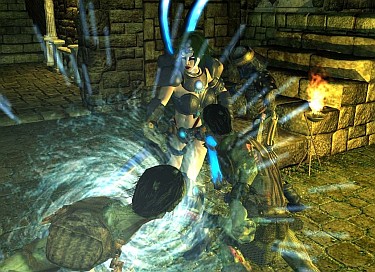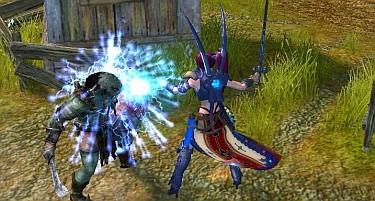I’ve been enjoying Sacred 2 on the Xbox 360 for the last couple of weeks. It’s a fast-paced, hack and slash game in the mode of Diablo and Phantasy Star Online. There are six character classes to choose from, and as I prefer to play as balanced, hybrid types, I picked a seraphim to start.
One of the coolest and least intuitive aspects of Sacred 2 is the character progression. Statistical progression is separated into three groups: attributes, skills, and combat arts. Attributes are things like strength, dexterity, and vitality, and aren’t any different than what you have encountered in numerous other RPGs. Skills are passive modifiers that enhance your character’s combat ability – for example, Concentration reduces the cooldown time on your special abilities (among other things). Combat arts are your character’s specific special attacks, spells, and buffs.
This progression system gives a wide latitude to the player with regard to how his or her character is developed. I’m currently playing as a dual-wielding, melee character, but if I wanted to play as a spell-flinging caster seraphim, I could have done that, and if I wanted to be a gat-blasting angel, I could have done that as well. For that matter, I could combine all of those into one sword-swinging, spell-flinging, gat-packing character. It’s up to the player whether he or she wants to roll with a character who is very proficient in a narrow combat speciality or a character who is very versatile but is somewhat weaker due to a lack of specialization.
Unfortunately, this system is very poorly explained in the manual and game, and it’s likely that new players are going to screw up their first character before figuring out how everything works. Admittedly, Sacred 2 isn’t unique in this respect, as I restarted my characters in both Diablo II and Phantasy Star Online several times before I felt comfortable with the stat systems in those games, and the game is forgiving enough that even a suboptimal character can do okay, at least at the lower intermediate difficulty level.
The controls are very comfortable on the console, which is surprising given the game’s PC origins. Combat arts are mapped to the face buttons, and the shoulder triggers are used in conjuction with the buttons to give the player access to twelve combat arts in total. The left bumper picks up all items within a short radius of the player. One aspect where the controller doesn’t work so well is for targetable abilities; you have to move a cursor on the screen to where you want the ability to be used, which is rather awkward, particularly when you’re being pelted by a dozen monsters.
Thus far I really like the game, and I’d encourage fans of hack and slash games to give it a try. The world is huge and beautiful, the action moves quickly, and it’s a lot of fun planning out your character.












